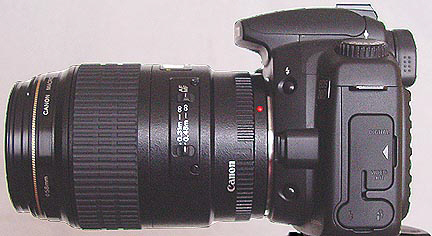

Canon
EF 100mm F2.8 Macro USM Lens A
performance evaluation of this lens.
The Sigma
28-200mm zoom and Canon 65mm 1-5X Macro lenses in my kit left a gap
in the range of objects I could capture. To fill it I decided a 100mm
macro lens would be the best compromise between cost and capability.
After reading several macro lens comparisons in this class, two
consistently rose to the top of the rankings: the Canon 100mm Macro
and the Tamron 90mm Macro. I decided on the Canon lens because it
offered 50-percent greater working distance, had a full time manual
focus option, featured nearly all-metal construction promising
greater durability and was only $75 more than the Tamron at the local
camera shop. While one review rated the Tamron as the (very) slightly
sharper of the two lenses, the Canon rated superior on flare and
color issues.
On-line sources for the Canon 100mm lens ranged in cost from $400 to $700. The Tamron averaged $50-$75 less. In the end I decided to purchase the Canon from the local store because their cost was $540 (mid-range for Internet sources) there were no gray-market issues to worry about and I didn't have to pay any shipping. Besides, supporting a local camera store is a good investment; I get a lot more from it than just camera equipment.
Description:

The Canon EF 100mm F2.8 Macro USM lens on a 20D camera
The lens weighs a little over one pound, is three inches in diameter and almost 5 inches long. The build quality appears very good, though there is 1/16th-inch play in the focusing ring, a side effect of the ring-drag system that prevents the lens from being damaged by jamming the focusing ring too hard at either end. The dappled surface has a hint of gray in it. On the top of the lens are the magnification and distance scales. On the left side is a focus limiting switch (reduces the near-distance so the auto focus doesn't hunt as long) and a switch to convert from auto to manual focusing.
All-in-all the lens has the heft and look of being worth its price.
Auto
Focus Tests:
I read conflicting reports about the this lens's autofocus capabilities. Some claimed it hunted a lot while others said it locked on quickly over its entire range. While the USM (ultrasonic motor) drive is fast and quiet, I found that even when given a friendly, high-contrast grid of lines it repeatedly fail to lock on when the target was 24-inches or closer to the front of the lens. At 30-inches the lock-on rate was 50-percent at at 36-inch it was virtually 100-percent. This was disappointing because I plan to do most of my work within 24-inches.
Further testing showed that this autofocusing problem was strongly effected by light levels. In bright light the lock-up rate was nearly 100-percent at any distance, equally so under low light levels when the camera sensed it needed to use the flash to obtain a good lock-on. However, in conditions of the lighting in an average house there is a range where there's not enough light for reliable autofocusing yet enough so that the flash isn't triggered to assist the focusing. In such conditions near focusing was unreliable with my camera and lens.
The auto focus (not USM) on my Sigma 28-200mm lens takes about 0.5 seconds to focus from infinity to objects 3-feet away. The Canon 100mm macro seemed to be half that. I actually prefer the pleasant whir of the Sigma lens's drive over the almost silent Canon lens, but then as a mechanical engineer I enjoy hearing the sound of running motors.
To test the accuracy of the Canon's autofocus I set up a black-on-white grid 45-degrees to the camera 36-inches away from the front of the lens, let the camera focus on an object 20 feet away, then brought it back to focus on the center of the target. By comparing the focus point to the actual focus point as captured in an image taken of the grid I was able to estimate that the autofocus focuses 0.5-inches in front of the point of apparent focus. This isn't an issue for objects at normal distances from the camera, but for close-up shots it's enough to soften the image because the depth of field is so short.
The following images show the focusing errors for various focusing schemes. (Note: all images on this page were taken with the camera on a worm-driven rack for optimum focusing and that mounted on a tripod, mirror lock-up mode enabled to reduce vibration and the shutter tripped with a remote release. All exposures were at F6.3. All images, except the first one of the lens, are unprocessed crops.) The point of actual focus captured in the images was to the left of the apparent focus of the central gap between the grid blocks, indicating that the actual focus was in front of the apparent focus because the left edge of the target was closest to the camera. Each grid block is 1-inch wide.
![]()
Canon autofocus
![]()
Canon manual focus
I had expected that manual focusing would be more accurate, especially since I took a great deal of time to make sure the focus was dead-on. The fact that it wasn't any better than autofocusing was surprising.
![]()
Canon manual
focus with Angle Finder C attachment
Canon makes a view finder attachment called Angle Finder C, which magnifies the image making sharper focusing possible. The problem is that with my Sigma 28-200mm lens the finder also magnifies the irregularities in the image so that you don't really gain anything. The Canon 100mm macro lens provides considerably sharper images in the finder and this makes the angle finder a useful tool, as the image above shows. The actual focus point is aligned with the apparent focus point much more closely, though still not perfectly.
![]()
Sigma 28-200mm
zoom lens autofocus test
The Sigma was slightly less accurate than the Canon, placing the actual focus 0.75 inches in front of the apparent focus.
![]()
Sigma 28-200mm
zoom lens with angle finder C attachment
Using the Angle Finder C attachment didn't help the Sigma because the image wasn't sharp enough in the view finder to take advantage of the increased magnification, hence the focusing accuracy as indicated by the photo above wasn't much better than the Sigma's autofocus.
Besides providing useful information about focusing accuracies, what the preceding tests taught me is that for macro work it's essential to not trust apparent or visual focusing. The shallow depth of field will almost certainly result in slightly out of focus images. Instead, it's best to take a sequence of images as the focus is slightly shifted closer to the camera in a series of small steps to make sure at least one image is in sharp focus. From this point on all images on this page are the sharpest of a series of 10 images taken in each test to make sure the absolute sharpest image was used.
Distortions:
To see what distortions the Canon EF 200mm F2.8 Macro USM lens had in comparison to my Sigma 28-200mm lens I took images of a box of white squares on a black background and looked for color artifacts and fuzziness near the edge of the frame.
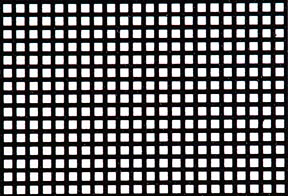
Center
section of the test grid. Each square is 1mm on a side.
![]()
![]()
Sigma
28-200mm lens at 200mm, 6-inches from target. The right
square
was in the center and left at the far left edge of the frame
![]()
![]()
Canon
100mm macro lens at a distance to match the Sigma's
image
scale. Same left-right orientation.
The Canon is significantly sharper and more color-free than the Sigma. To push the Canon I moved the camera forward to its closest focus limit, 6-inches, and took another set of images with the lens working at 1X.
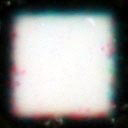
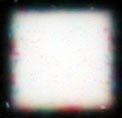
The box on the left was from the extreme upper left hand corner. The one on the right was from the center of the frame. Sharpness is almost the same in both frames. The corner box shows a small amount of color fringing, though still much less than the Sigma at lower magnification. More interesting is that the corner box has been distorted, appearing 5-percent taller than the center box. Looking back the the previous two tests shows that this effect is evident in both the Sigma and Canon lenses. What surprises me is that this distortion is only in the vertical, making the corner boxes appear rectangular.
Real-World
Image Comparisons:
While images of black and white grids can tell a lot about what a lens can and can't do, they don't provide a feel for what the lens will do in the real world. Since I plan on using the Canon 100mm macro lens mainly for taking close-up pictures of hummingbirds and hummingbird feathers, I decided to see how it compared to my other two lenses, the Sigma 28-200mm zoom and a Canon 65mm 1-5x macro photo lens, by taking pictures of a feather. These images were taken with the front of the lens 24 inches from a feather. The section of the feather in these images is 0.25-inches tall. The following four images are all unprocessed crops, except for the second which is an up-sampled version of the first image to put it at the same scale as the remaining two images.
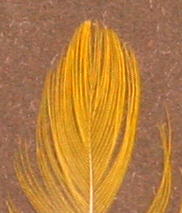
Sigma
28-200mm at 100mm
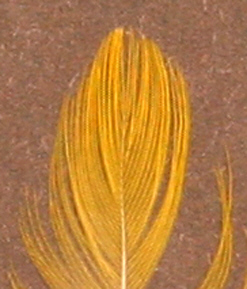
Same
image as above up-sampled to the same size as the
Canon
100mm lens to make comparison easier.
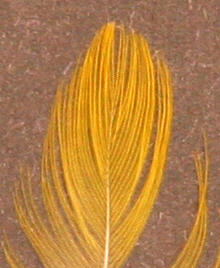
Sigma
28-200mm lens at 200mm
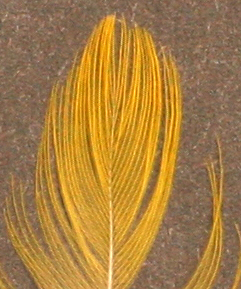
Canon
EF 100mm F2.8 Macro USM lens
What these images show is that the Canon is clearly superior to the Sigma, even when the Sigma is working at 200mm to the Canon's 100mm. This surprised me because while I anticipated that the Canon would be superior to the Sigma with both lenses working at 100mm, I expected the Sigma to have an advantage when working at 200mm over the Canon's 100mm.
The real challenge for the 100mm macro lens was in putting it up against Canon's 65mm 1-5X macro lens. I spite of it's being essentially a zoom lens, I found an on-line comparison between the 65mm macro and ten other macro lenses that found it to provide the sharpest images of all at 1X.
The following images are of the center of the same feather at 1X.
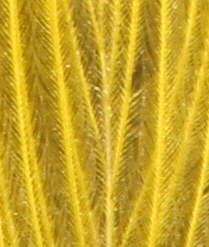

.............Canon 100mm macro at 1X.....Canon 65mm 1-5X Macro at 1X.........
For scale the tiny barbs angling off the sides of the main ribs are only 0.002-inches in diameter. To my eye the Canon 65mm lens is slightly sharper, a testament to the outstanding quality of this lens. Each of the above images was the sharpest of 15 images taken in sequence as the camera was racked away from just inside to just outside the best apparent focus in 0.010-inch steps, so I'm confident that in this case focus was not an issue.
Hunting
for
the Sweet Spot:
Because the design of every lens represents a compromise between many conflicting parameters, no lens works perfectly over its entire operating range. In use this manifests itself in prime lenses as the lens providing the sharpest image at one particular focal ratio, usually 2-3 stops down from wide open. The following images show how the Canon 100mm macro lens performs in this range:
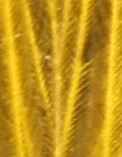
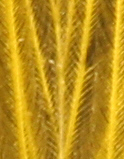
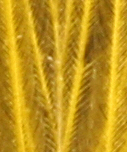
F5.6...................F6.3....................F8.0
Again, each of these images were the sharpest of ten or more images taken in sequence as the camera was racked from just inside the point of best focus to just outside to insure that focusing issues did not play a significant factor.
These images suggest that this lens's sweet spot appears to be at F6.3.
Working
Distance and Depth of Field Chart: NEW!!!
By photographing a grid set 45-degrees to the optical axis of the lens at different distances it's possible to assemble a chart correlating the working distance to the depth of field. The problem with such measurements is that "depth of field" depends on the observer. Some people are more forgiving than others about what they consider acceptably sharp. I do not know if I have high or low standards so please take the following DOFs with a grain of salt. The chart below is for the lens set to F6.3.
Macro
Factor......Focal
Distance .....Working
Distance.... DOF(inches) --DOF(mm)
........................(Distance
on lens)...(Target
to lens front)
........1X.................12-inches...............5.75-inches.................0.18..............4.7
........75X..................13.7-inches..............7.25-inches.............0.29..............7.3
.........5X...................15.5-inches..............9.25-inches.............0.39............10.0
........33X...................19.2-inches............13.6-inches..............0.60............ 15.3
........2X................... 29-inches...............22.7-inche................0.78............ 19.9
The in-focus field width (size of object that will span the sensor's entire width) at each of the distances above is the product of the magnification factor (MF) indicated on the lens multiplied by the sensor width.
MF1 (yellow scale on top of the lens) = Macro factor of 1 with a field width of 1-inch
MF2 = Macro factor of .5 with a field width of 2-inches
MF3 = Macro factor of .33 with a field width of 3-inches and so on.
Final
Comments:
As a newcomer to photography I am too limited in knowledge and experience to make any lens recommendations so please don't take my comments as gospel. Also, it's extremely unfair to compare a third-party zoom lens to a first-party prime lens. The zoom has to make many more design compromises to operate over such a wide range of focal lengths. I did so not to show that the Sigma was a poor lens, but rather to compare how the Canon performs relative to the only other lens I had that covers approximately the same range of object sizes.
I hope you've enjoyed this page and found it useful. Thank you for visiting!
Return to my homepage and browse 20 other photography pages or 80 different general interest pages: everything from metal detectors to the strange world of lucid dreaming.